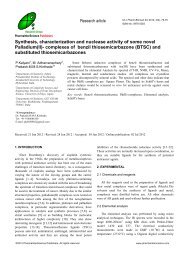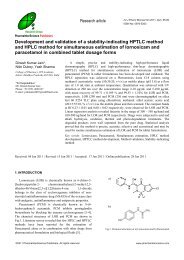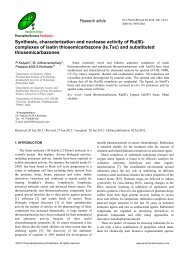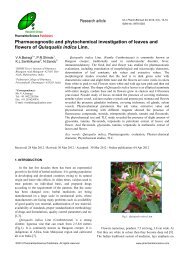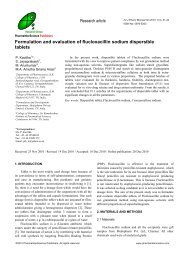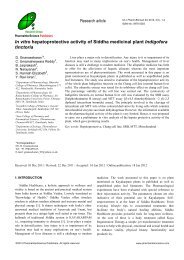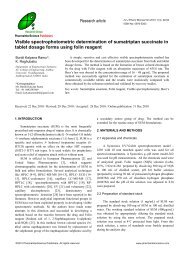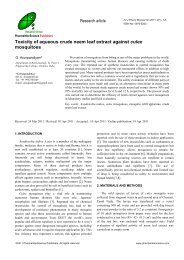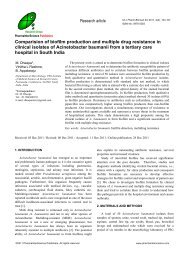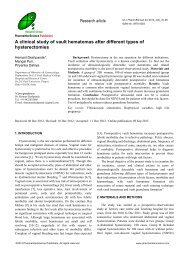Synthesis, characterization and antimicrobial studies on transition ...
Synthesis, characterization and antimicrobial studies on transition ...
Synthesis, characterization and antimicrobial studies on transition ...
You also want an ePaper? Increase the reach of your titles
YUMPU automatically turns print PDFs into web optimized ePapers that Google loves.
S. Sunitha <str<strong>on</strong>g>and</str<strong>on</strong>g> K.K. Aravindakshan, Int J Pharm Biomed Sci 2011, 2(4), 103-113<br />
109<br />
2. MATERIALS AND METHODS<br />
All chemicals used in the present work viz.,aniline,<br />
benzoylchloride, ethylacetoacetate, phenylhydrazine,<br />
is<strong>on</strong>iazid, metal salts, solvents etc., were of AR grade. (BDH,<br />
Sarabhai, Qualigens, E. Merck, Loba Chemie or Glaxo).<br />
Carb<strong>on</strong>, hydrogen <str<strong>on</strong>g>and</str<strong>on</strong>g> nitrogen analyses were carried out<br />
by using VarioEL III CHNS analyser at SAIF, CUSAT,<br />
Kochi. The ani<strong>on</strong>s present in the complexes were estimated<br />
by st<str<strong>on</strong>g>and</str<strong>on</strong>g>ard methods. The 1 H NMR spectrum of the lig<str<strong>on</strong>g>and</str<strong>on</strong>g><br />
was recorded <strong>on</strong> Advance III 500 MHz Bruker spectrometer<br />
using DMSO-d 6 as solvent. Infrared spectra were measured in<br />
the range 4000-400 cm -1 as KBr pellets <strong>on</strong> a Perkin-Elmer<br />
spectrophotometer. The solid-state electr<strong>on</strong>ic spectra of the<br />
complexes were recorded <strong>on</strong> a JASCO UV-Visible<br />
spectrophotometer. The magnetic measurements were made<br />
at room temperature by Evans method using Hg[Co(CNS) 4 ]<br />
as calibrant.<br />
2.1 <str<strong>on</strong>g>Synthesis</str<strong>on</strong>g> of the compounds<br />
The synthesis of the lig<str<strong>on</strong>g>and</str<strong>on</strong>g> c<strong>on</strong>sisted of three stages. The<br />
first stage which involves the preparati<strong>on</strong> of 3-methyl-1-<br />
phenyl-5-pyrazol<strong>on</strong>e[5] <str<strong>on</strong>g>and</str<strong>on</strong>g> the sec<strong>on</strong>d stage which involves<br />
the benzoylati<strong>on</strong> of the above to 4-benzoyl-3-methyl-1-<br />
phenyl-5-pyrazol<strong>on</strong>e were carried out using Jensen’s<br />
procedure [6]. The third stage involved the c<strong>on</strong>densati<strong>on</strong> of<br />
4-benzoyl-3-methyl-1-phenyl-5-pyrazol<strong>on</strong>e with distilled<br />
aniline to prepare the Schiff base lig<str<strong>on</strong>g>and</str<strong>on</strong>g>. Added an ethanolic<br />
soluti<strong>on</strong> of aniline (0.0109 mol, 1mL) to a hot refluxing<br />
soluti<strong>on</strong> of 4-benzoyl-3-methyl-1-phenyl-5-pyrazol<strong>on</strong>e(0.01<br />
mol, 2.7840 g) in ethanol <str<strong>on</strong>g>and</str<strong>on</strong>g> refluxed for 3 h .The lem<strong>on</strong><br />
yellow coloured crystals obtained <strong>on</strong> cooling were filtered at<br />
the pump, washed with ethanol <str<strong>on</strong>g>and</str<strong>on</strong>g> dried (yield= 65.8%).<br />
Complexes of Co(II) with this lig<str<strong>on</strong>g>and</str<strong>on</strong>g> were synthesized<br />
using iodide <str<strong>on</strong>g>and</str<strong>on</strong>g> nitrate salts of the metal. Complexes of<br />
Ni(II) with this lig<str<strong>on</strong>g>and</str<strong>on</strong>g> were synthesized using acetate salt of<br />
the metal. Complexes of Cu(II) of this lig<str<strong>on</strong>g>and</str<strong>on</strong>g> were<br />
synthesized using acetate, chloride, nitrate <str<strong>on</strong>g>and</str<strong>on</strong>g> sulphate salts<br />
of the metal. Soluti<strong>on</strong>s of the lig<str<strong>on</strong>g>and</str<strong>on</strong>g> <str<strong>on</strong>g>and</str<strong>on</strong>g> iodide <str<strong>on</strong>g>and</str<strong>on</strong>g> nitrate<br />
salts of Co(II) salts in methanol (2:1 molar ratio) were<br />
refluxed for 0.5h. Acetate of Ni(II)salt, nitrate <str<strong>on</strong>g>and</str<strong>on</strong>g> sulphate<br />
salts of Cu(II) were dissolved in water <str<strong>on</strong>g>and</str<strong>on</strong>g> added to the<br />
refluxing soluti<strong>on</strong> of the lig<str<strong>on</strong>g>and</str<strong>on</strong>g> in methanol (1:2 molar ratio)<br />
<str<strong>on</strong>g>and</str<strong>on</strong>g> refluxed for 2h. Acetate of Cu(II) was dissolved in<br />
ethanol <str<strong>on</strong>g>and</str<strong>on</strong>g> added to a refluxing soluti<strong>on</strong> of methanol(1:2<br />
molar ratio) <str<strong>on</strong>g>and</str<strong>on</strong>g> refluxed for 15 min. The chloride of Cu(II)<br />
was dissolved in methanol <str<strong>on</strong>g>and</str<strong>on</strong>g> added to refluxing soluti<strong>on</strong> of<br />
the lig<str<strong>on</strong>g>and</str<strong>on</strong>g> in methanol (1:2 molar ratio) <str<strong>on</strong>g>and</str<strong>on</strong>g> refluxed for 7.5h.<br />
The complexes formed <strong>on</strong> cooling were filtered off, washed<br />
with the respective solvents <str<strong>on</strong>g>and</str<strong>on</strong>g> dried except the complex<br />
synthesized using the chloride of Cu(II) in which case the<br />
volume was reduced to half by evaporating off the solvent.<br />
The solid which separated was filtered off, washed with the<br />
solvent <str<strong>on</strong>g>and</str<strong>on</strong>g> dried.<br />
3. RESULTS AND DISCUSSION<br />
3.1 Characterizati<strong>on</strong> of the lig<str<strong>on</strong>g>and</str<strong>on</strong>g><br />
The lig<str<strong>on</strong>g>and</str<strong>on</strong>g> was characterized by m.p., elemental<br />
analysis, 1 H NMR <str<strong>on</strong>g>and</str<strong>on</strong>g> IR spectral data. The 1 H NMR<br />
spectrum of the lig<str<strong>on</strong>g>and</str<strong>on</strong>g> was recorded in DMSO-d 6 <str<strong>on</strong>g>and</str<strong>on</strong>g> it<br />
showed a number of characteristic signals of the compound<br />
[7,8]. The singlet observed at 1.4 ∂ was assigned to the<br />
methyl group at 3 positi<strong>on</strong> of the pyrazol<strong>on</strong>e ring. The<br />
multiplet observed in the range 7.0-7.5 ∂ was assigned to the<br />
aromatic prot<strong>on</strong>s. The singlet at 8.0 ∂ was assigned to the<br />
prot<strong>on</strong> at 4 positi<strong>on</strong> of the pyrazol<strong>on</strong>e ring. Singlets at 2.4 ∂<br />
<str<strong>on</strong>g>and</str<strong>on</strong>g> 3.4 ∂ are due to DMSO-d 6 <str<strong>on</strong>g>and</str<strong>on</strong>g> H 2 O. The IR spectrum of<br />
the lig<str<strong>on</strong>g>and</str<strong>on</strong>g> showed a number of absorpti<strong>on</strong> b<str<strong>on</strong>g>and</str<strong>on</strong>g>s which were<br />
characteristic of the different groups present in it [7,8]. The<br />
b<str<strong>on</strong>g>and</str<strong>on</strong>g>s present at 1628 cm -1 <str<strong>on</strong>g>and</str<strong>on</strong>g> at 1226 cm -1 have been<br />
assigned to >C=N <str<strong>on</strong>g>and</str<strong>on</strong>g> C-N stretching vibrati<strong>on</strong>s,<br />
respectively. The characteristic frequency due to the<br />
stretching of the aromatic keto group, at 1650 cm -1 was not<br />
present in the spectrum, which indicated that c<strong>on</strong>densati<strong>on</strong><br />
between 4-benzoyl-3-methyl-1-phenyl-5-pyrazol<strong>on</strong>e <str<strong>on</strong>g>and</str<strong>on</strong>g><br />
aniline was complete. The b<str<strong>on</strong>g>and</str<strong>on</strong>g> at 1500 cm -1 has been<br />
assigned to >C=O group of the pyrazol<strong>on</strong>e ring. The b<str<strong>on</strong>g>and</str<strong>on</strong>g>s<br />
due to the in plane bending of the aromatic C-H stretching<br />
are usually found in the range 1250-950 cm -1 . The b<str<strong>on</strong>g>and</str<strong>on</strong>g>s at<br />
1138 cm -1 , 1007 cm -1 <str<strong>on</strong>g>and</str<strong>on</strong>g> 906 cm -1 have been assigned to<br />
these modes of vibrati<strong>on</strong>s. The most characteristic<br />
frequencies of aromatic groups were found below 900 cm -1 ,<br />
usually in the range 600-900cm -1 , due to the out-of-plane<br />
bending vibrati<strong>on</strong> of the aromatic C-H. The b<str<strong>on</strong>g>and</str<strong>on</strong>g>s at 770cm -1 ,<br />
760 cm -1 <str<strong>on</strong>g>and</str<strong>on</strong>g> 698 cm -1 have been assigned to these modes of<br />
vibrati<strong>on</strong>s. The elemental analysis <str<strong>on</strong>g>and</str<strong>on</strong>g> spectral data for L are<br />
c<strong>on</strong>sistent with the formula C 23 H 19 N 3 O.<br />
3.2 Formulae <str<strong>on</strong>g>and</str<strong>on</strong>g> general properties of complexes<br />
The reacti<strong>on</strong> of the lig<str<strong>on</strong>g>and</str<strong>on</strong>g> (L) with different salts of<br />
Co(II), Ni(II) <str<strong>on</strong>g>and</str<strong>on</strong>g> Cu(II) i<strong>on</strong>s in 2:1 molar ratios gave metal<br />
complexes of the given formulae, as evidenced by the microanalytical<br />
<str<strong>on</strong>g>and</str<strong>on</strong>g> spectral data.<br />
1. [ML 2 X 2 ]where M=Co(II), Ni(II) or Cu(II) <str<strong>on</strong>g>and</str<strong>on</strong>g><br />
X=CH 3 COO - , I - or NO 3<br />
-<br />
2. [Cu(L) 2 SO 4 ]<br />
Suggested structure for [ML 2 X 2 ] <str<strong>on</strong>g>and</str<strong>on</strong>g> [Cu(L) 2 SO 4 ] are<br />
shown in Fig.3 <str<strong>on</strong>g>and</str<strong>on</strong>g> Fig.4, respectively. The colours, magnetic<br />
susceptibilities, molar c<strong>on</strong>ductivities <str<strong>on</strong>g>and</str<strong>on</strong>g> melting points <str<strong>on</strong>g>and</str<strong>on</strong>g><br />
the micro-analytical data of the complexes are listed in<br />
Table 1. These air-stable metal complexes were n<strong>on</strong>hygroscopic,<br />
partially soluble in most of the organic solvents<br />
but freely soluble in DMF <str<strong>on</strong>g>and</str<strong>on</strong>g> DMSO. The molar<br />
c<strong>on</strong>ductivities in DMF/DMSO (10 -3 M) showed that all the<br />
complexes behaved as n<strong>on</strong>-electrolytes, indicating the<br />
coordinated nature of the ani<strong>on</strong>s.<br />
©2011 PharmaInterScience Publishers. All rights reserved. www.pharmainterscience.com




